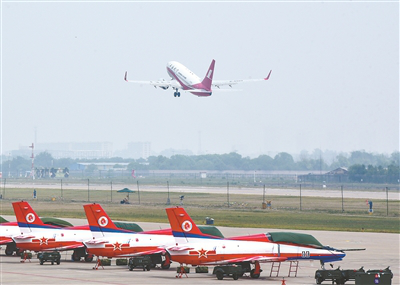
The picture shows a civil airliner takes off from a dual-use airport in northwest China. Photo by Yan Qiaoyu
LHASA, Xizang, Aug. 2 (ChinaMil) -- Lhasa Gonggar Airport of China’s Xizang Autonomous Region witnesses over 100 inbound and outbound flights every day since the beginning of the tourist season.
An official of the civil aviation department introduced that this military-civil dual-use airport has transported more than four million passengers and the cargo and mail throughput has reached 36,000 tons annually since it was put into use.
The airport has made great contributions to Xizang's economic construction. It is reported that the Chinese Air Force has opened up nearly 60 airports for military-civil use as of now.
It is known that the military and civil use of some airports of the Chinese PLA Air Force has begun since 1985. More than 30 years’ practice has proved that dual-use of military airports benefits the country, the armed forces and the people.
The official of the Airport Department of the Civil Aviation Administration of China introduced that due to the huge cost of airport construction and harsh site selection conditions, the ideal geographical locations of the airport can be scarce, especially in areas such as plateaus and mountains.
The Chinese PLA Air Force opened its airports for military and civil use, which can help avoid the repeated construction of airport facilities in the same area, and greatly save the national construction cost.
At the same time, the military-civil dual-use airport has extremely important practical significance and strategic benefits. For the Air Force, dual-use airport can greatly enhance the support capability of military airports. For civil aviation companies, dual-use airport can strengthen its transportation capacity, increase passenger and cargo throughput volume, and ease the pressure on civil airports.
According to statistics, nearly 60 dual-use airports have jointly secured 1.038 million flights and transported 92.21 million passengers since 2018, accounting for 7.3 percent of the national total.









